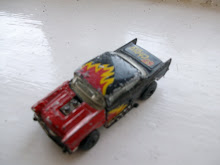It was originally released in 1990, but I came to it a few years later. Despite that, it still took me back with it graphics and the way the action held together. In brief: you were a rookie pilot doing your bit for the people of Earth in a huge war in space against the ruthless Kilrathi, who were anthropomorphic cat folk with a tough line in tradition and honour.
In hindsight, the story was incredibly linear, but by simple virtue of being able to choose your own name and "callsign" it offered a layer of immersion that was very rewarding for the time. You were thrown right onto the front as part of the crew of the Tigers Claw, most the "storyline" taking place in the bar.
 |
| Drink helps with the space shakes, I'm told. |
The success of Wing Commander meant a sequel quickly followed in 1991. In this, our hero finds his hero status relinquished due to odd circumstances, and he's packed off for ten years doing nothing work. Obviously, he finds his way back to the action to earn a chance to clear his name and save Earth, again. I can only assume Roberts got a bit excited, as the storyline offered more depth, with romantic interludes (yuck!), a Kilrathi defector on the crew and a human traitor in the ranks. Larks!
 |
| Instead of denying it, why not embrace death? It is your only friend now. |
Unfortunately, for the third instalment, Chris Roberts fancied himself as George Lucas and wanted to make the scenes between missions all Full Motion Video. FMV had the double issue of being incredibly expensive and it took bloody ages to load up every scene. Also, within a few years as technology moved on, it all tended to look a bit ropey. Another of my favourite games, Gabriel Knight: Sins of the Fathers, went down the same path with the second in the series, The Beast Within, which has dated ten times worse than the older game.
At least 1994's Wing Commander III managed to snare some decent acting talent: Mark Hamill, John Rhys-Davies and Malcolm McDowell all rocked up to do credible jobs to the degree there were additional sequels. I had lost interest, though - the appeal of the first two in the series was that the main guy had MY name and I read his lines in MY voice. Suddenly, he looked and sounded like Mark Hamill and was called Christopher Blair, which is a frankly shite name for the hero of a space war hero.
 |
| Back in space again, eh? Bloody typecasting! |
